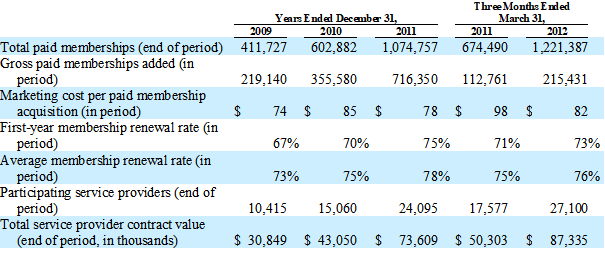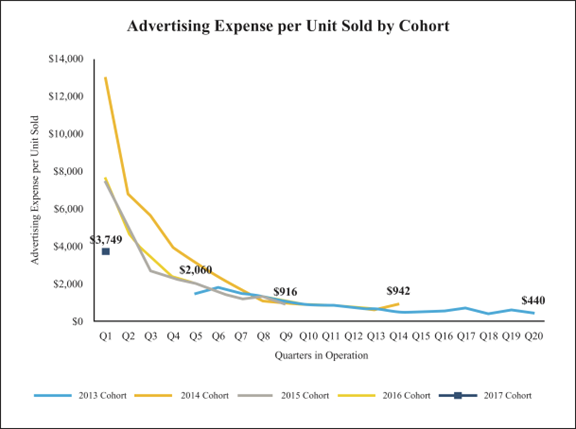One of the most important metrics for B2C companies is customer acquisition cost also known as, CAC. One debate is whether the cost rises or falls over time. The argument for rising CAC is the next marginal customer is generally harder to acquire than your last customer. The argument for falling/stable CAC is that as companies get larger, they benefit from scale and brand recognition.
Find your next investor and upgrade to Crunchbase Pro.
We took a look at publicly available data for B2C companies which disclosed CAC, and while there were only three we could find, the data is interesting.
3 examples of why CAC doesn’t have to rise as you grow
Wayfair’s CAC grew by 12% annually while marketing spend increased 2.3x.
Wayfair, an online purveyor of housewares, reported CAC of $45 in Q3 2013 versus $36 in Q3 2011. While that seems like high growth in CAC, it’s nominal when you consider that marketing expense increased from $9mm to $21mm over that same time. Overall, CAC grew at a compound annual growth rate of 12% each year. The rate is remarkably low given that marketing spend more than doubled over the same period.

Angie’s List had stable CAC while tripling marketing spend
Angie’s List, an online review site with memberships, had very little change in CAC from 2009 to 2011 with CAC of $74, $85, and $78. Over the same period, paid memberships went from 411k to 1.1mm and marketing expense rose from $16mm to $56mm. In other words, marketing expense more than tripled but CAC stayed the same. Remarkable scale.

Carvana’s CAC declines as customers age
Carvana, which sells cars online, showed their CAC on an annual cohort basis. In other words, they group customers by the year that customer was acquired (a cohort), look at the units the cohort has bought over time and compares that to the initial cost to acquire the customer. In other words, acquisition cost is the numerator and units purchased over time is the denominator.
So long as you keep the customer and they make repeat purchases, the cost of acquiring that customer drops when viewed this way because the marketing expense to get the cohort didn’t change (the numerator), but the units purchased increases ever year (denominator). For instance, the 2017 cohort at the time of their S1 filing had cost the company $3,700 per customer, whereas the 2013 cohort which has had the benefit of an additional 4 years of sales versus the 2017 cohort, now has a CAC of $440.

We wish we had more data from public companies, but based on what we do have from Angie’s List and Wayfair, it shows that it is possible to dramatically increase marketing spend while seeing marginal or no increase in CAC.
Sammy is a co-founder of Blossom Street Ventures. We invest in companies with run rate revenue of $2mm+ and year over year growth of 50%+. We lead or follow in $1mm to $5mm growth rounds and can do inside rounds, secondaries, restructurings and special situations. We’ve made 16 investments all over the US in SaaS, e-commerce, marketplaces, and low-tech. We can commit in 3 weeks and our check is $1mm. Email Sammy directly at sammy@blossomstreetventures.com.






